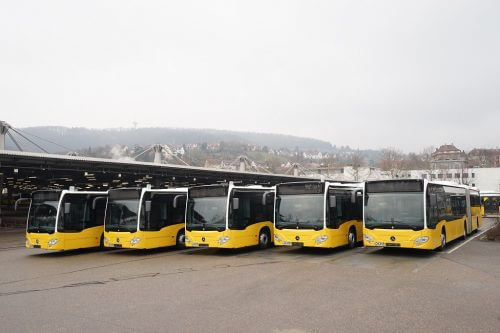
Stuttgart operator becomes first recipient of Daimler’s new hybrid Mercedes-Benz Citaro
GERMANY The first new Mercedes-Benz Citaro hybrids are gradually going into service with Stuttgarter Strassenbahnen AG (SSB). Based on the hybrid technology recently unveiled by Mercedes-Benz, the five articulated vehicles are expected to deliver a fuel saving of up to 8.5%.
Initially they will be used on inner city routes, but late in 2018 they are expected to switch to the new X1 express bus service being introduced by SSB especially for low-emission buses.
“The objective with the Citaro hybrid is to make the diesel engine even more economical while optimising the degree of electrification for maximum overall economic efficiency,” said Rüdiger Kappel, Sales Manager Mercedes-Benz Buses Germany. A disc-shaped electric motor is positioned between the engine and the automatic transmission. On overrun or when the bus is braking – the energy recovery phase – the motor acts as a generator to produce electric power, which is briefly stored by the Citaro hybrid incapacitors, so-called mild hybrid storage (MHS). When the bus accelerates again, the electric motor uses the stored energy to assist the diesel or gas engine with extra torque. Mercedes-Benz calls this the support phase. The electric motor has a maximum output of 14kW with a torque of 220Nm.
The advantage of the hybrid drive is that on acceleration, the combustion engine needs to deliver significantly less power thanks to the electric support, thus saving fuel. The electric motor also provides assistance at idle.
With regard to the components installed, Mercedes-Benz Buses has intentionally opted for in-house large-scale production. For example, the electric motor serves as a starter-alternator in the current S-Class, while the additionally required cooler for the motor and inverter is used by Mercedes-Benz Trucks and the water pump can be found in many Mercedes-Benz cars.
Another innovation that benefits overall economic efficiency is ‘intelligent eco steering’ – electrohydraulic steering that cuts in only when required, thus saving fuel. All components are designed to last for the duration of the vehicle’s entire service life. Another positive factor in the LCC (Life Cycle Cost) calculation is that the electric support lightens the load on the combustion engine while also taking work off the brakes during deceleration, which prolongs their service life.
Daimler says the Citaro hybrid makes life easy when it comes to providing after-sales service. Besides the series-produced parts used for the electric motor, energy storage and cooling, the absence of high-voltage technology is another key factor. The 48V system is classed as low-voltage technology and can be handled without risk of injury. The ancillary components remain unchanged and are driven conventionally. The maintenance intervals for the Citaro hybrid are also identical, at 60,000km or once a year; the same applies to all maintenance points on the conventional powertrain.

